Technology
Numeric grabs $28M Series A to automate accounting using AI

Accountants typically dread month-end and quarter-end closings. That’s because finalizing financial records for a specific period is generally a manual, error-prone and time-consuming endeavor.
In 2020, Parker Gilbert (pictured above; middle) was so fed up with the tedium of managing finance and accounting at an early-stage startup that he decided to co-found Numeric, an accounting software that automates certain parts of the book-closing process. And the introduction of genAI several years later significantly enhanced Numeric’s capabilities, so much so that it’s now used by the accounting departments of companies like Brex, OpenAI, Plaid and Wealthfront.
Over the last year, Numeric’s revenue has increased four-fold to the single-digit millions, and investors are suddenly flocking to back the company. Now, just five months after it raised a $10 million seed round from a slew of well-known investors, the company has raised a $28 million Series A led by Menlo Ventures, with participation from new investors IVP and Socii. Previous backers Founders Fund, Long Journey, 8VC, Friends & Family Capital, and Fifth Down also invested in this round.
Numeric lets accounting teams shave days off their monthly book-closing process, Gilbert told TechCrunch. The company’s product achieves this by aggregating and reconciling data from various accounting systems and Excel spreadsheets. It then overlays that data with an AI agent, which looks for how each line item changed from the previous month. If the agent spots outliers or unexpected variations, it explains why the account has increased or decreased, saving accountants a lot of time they would otherwise spend documenting variance in accounts — a process known as flux analysis.
Gilbert, the CEO of the startup, explained with an example: If the AI agent notices that Numeric’s legal expenses were much higher in October than in September, it would write an explanation along the lines of, “Your legal expenses went up this month because you paid Wilson Sonsini $X amount more for your funding.”
The possibility of AI hallucinations in the flux analysis commentary is one of the first concerns to come to mind, but Gilbert stressed that’s typically not a problem — he said Numeric always provides links so accountants can check the AI agent’s work at any time.
While the actual tie-out and calculations are not done by generative AI at the moment, Gilbert expects Numeric’s model to soon be capable of doing that accurately. “In terms of synthesizing large quantities of data, LLMs are incredibly good at this today, and I think are going to only increasingly get better,” he added.
Croom Beatty, a partner at Menlo Ventures, said he has spent a lot of time looking for a company that is disrupting accounting software, and Numeric was one of the first startups in the category to pique his interest.
“Numeric’s moat is a lot deeper than a lot of areas we were looking at,” he said. “It marries complex workflow with complex data in a market that has not been well served by tech companies.”
Beatty expects the company will be able to add other products in the future, such as financial planning and analysis capabilities — a market that Anaplan now dominates.
Numeric competes with two accounting software companies: Publicly-traded Blackline, and FloQast, an 11-year-old startup that was valued at $1.6 billion when it raised its Series E this April.
As for why there aren’t other, new AI-powered entrants in the accounting software market, Beatty said what Numeric is doing is very complex and not easily replicable.
Technology
SpaceX alums are working to raise a hefty $550M first deep tech fund
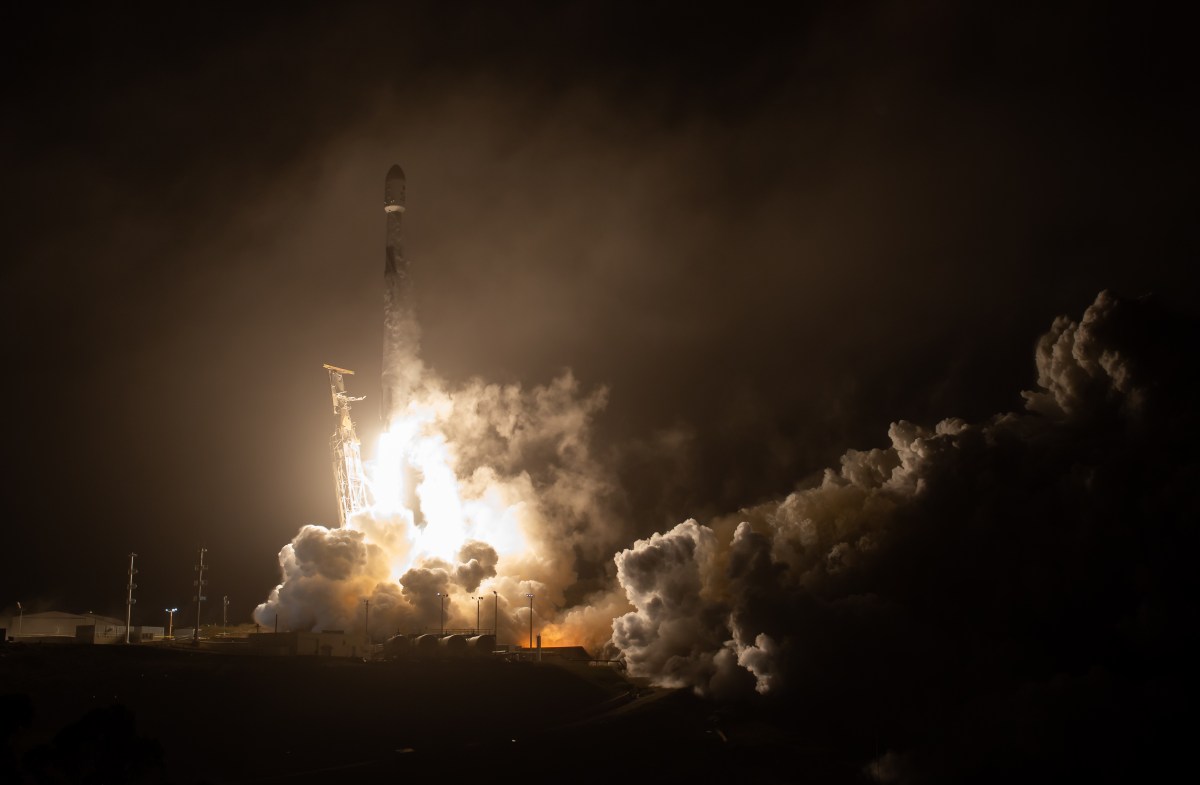
Interlagos, the venture capital firm started by former senior SpaceX leaders, is looking to raise $550 million for its first venture fund, according to regulatory filings and a confidential deck sent to prospective LPs and viewed by TechCrunch.
The existence of the firm was first reported by TechCrunch in April, but almost nothing has been publicly disclosed about its prospective investment thesis — until now. El Segundo-based Interlagos is broadly targeting startups across “deep tech” sectors, someone familiar with the firm’s plans said. The firm will provide capital from inception through Series B, with the targeted $550 million to be deployed across 26-32 investments, the deck says.
It’s a massive target for a first-time fund, which the team recognizes. “We are sized to lead and be persistent capital partners to leading companies,” the pitch deck says.
While the filing does not yet list how much money the partners have secured to date, a source familiar with the matter says that the firm has made a first close for a chunk of that $550M target. Prospective LPs are no doubt drawn to the bona fides of the founding team, which includes Achal Upadhyaya, who was a senior engineer at SpaceX for a decade before leading investments in space and defense at Cantos Ventures; Tom Ochinero, a former high-ranking SpaceX executive who left the company in March after a ten-year stint; and Spencer Hemphill, Interlagos’ CFO who was a former Sequoia finance leader.
The general partners will also have their own skin in the game — which is a common structure for VC firms. They have each pledged to invest a 2% general partner “commit”, the deck says, which refers to their own personal money they will commit to the fund as investors. The rest of the fund’s terms look industry standard as well: 2% management fees, 20-25% carry meaning how much the fund will keep of its returns, pursuit of deals that will give it 18-25% stakes in the startups it backs.
Ochinero, who reported directly to SpaceX President Gwynne Shotwell, was “personally responsible for over a billion dollars of annual revenue” at the company, according to a bio published in 2023. Upadhyaya in particular has a sweeping track record into deep tech startups as an angel and VC, according to the deck: He led the first investments into unmanned defense systems startup Neros Technologies and quantum mechanics startup SoloPulse, and the seed rounds into Shinkei Systems and Pilgrim, in his role at Cantos. His personal investments include Base Power, composites startup Layup, and Oxide Computer.
Upadhyaya did not respond to TechCrunch’s request for comment by publication time.
Deep tech, a umbrella term that can include sectors like space, manufacturing, robotics, biotech, AI and more, has seen a surge of VC interest in recent years. Deep tech companies require more upfront capital and tend to have longer exit timelines, which has led to an increase in specialist funds, often composed of technical partners. But still, if Interlagos manages to raise the full targeted amount, it would make it an exception to the recent downturn in VC that has made raising capital harder. It will also likely set the firm up to successfully compete against mega-funds like Founders Fund and Andreessen Horowitz, which have aggressively moved into the earliest stages in deep tech VC deals.
Servers computers
CCTV Big server rack || cctv #technology #serverrack #youtubeshorts #viral
Science & Environment
What is Elon Musk’s Starship space vehicle?
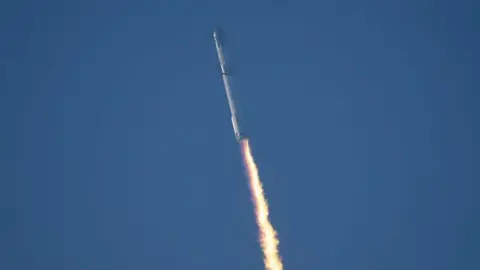 Getty Images
Getty ImagesElon Musk wants his new rocket to revolutionise spaceflight. And that rocket, Starship, is now the largest and most powerful spacecraft ever built.
It’s also designed to be fully and rapidly reusable. His private company SpaceX, which is behind the creation, is hoping to develop a spaceship that can be used more like a plane than a traditional rocket system, being able to land, refuel and take off again a few hours after landing.
When will Starship’s next launch be?
While there’s no exact date set yet for the rocket’s next flight, it could be as soon as this weekend – and SpaceX is expecting big things.
This will be Starship’s fifth outing, and all eyes will be on the landing phases – specifically, the return of the vehicle’s bottom part, the Super Heavy booster.
So far we’ve only seen what might be called a simulated landing at sea, or ‘splashdown’. This will be the first time we hope to see the booster return to the launch pad.
For a spacecraft to be reusable, it needs to be able to land safely.
The SpaceX founder has said they will try to catch the booster in mid-air on its return to Earth using the giant mechanical arms, or ‘chopsticks’, of the launch tower – or as Musk calls it, “Mechazilla”.
That’s something that’s never been done before, and eventually SpaceX want to catch the Ship – the top part of the vehicle – in the same way. But that won’t happen on the upcoming test flight.
Will Starship go to Mars?
None of Starship’s missions so far have been crewed, and there’s no plans to put people aboard for the next flight either.
But Musk and his company do have grand designs that the rocket system will one day take humanity to Mars.
A Mars trip isn’t on the horizon just yet. But the behemoth rocket already has some impressive specs, and dwarfs all of its predecessors.
How big and powerful is Starship?
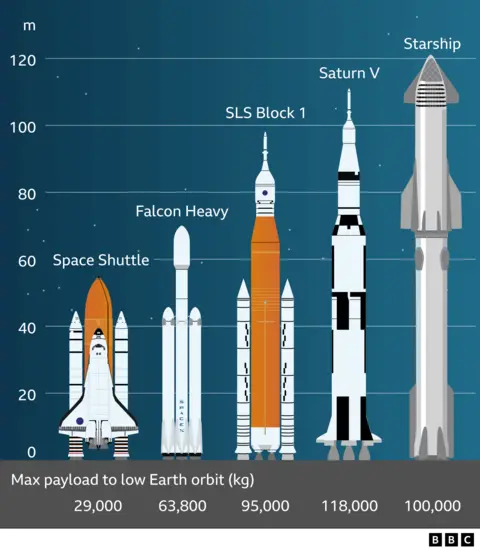
Starship is a two-stage vehicle. The “Ship” is the uppermost part, and that sits atop a booster called Super Heavy.
Thirty-three engines at the base of this booster produce around 74 meganewtons of thrust. To put that into perspective, it’s almost 700 times as powerful as the thrust generated by the common passenger plane, the Airbus A320neo.
If you’ve flown with Aer Lingus, British Airways or Lufthansa, imagine the kick of taking off in one of those planes. Then multiply that by 700.
The vehicle has grown about a metre since its second test flight in June of this year, with Starship now measuring just over 120m in total.
This additional height comes from the Super Heavy booster itself being made 1m longer.
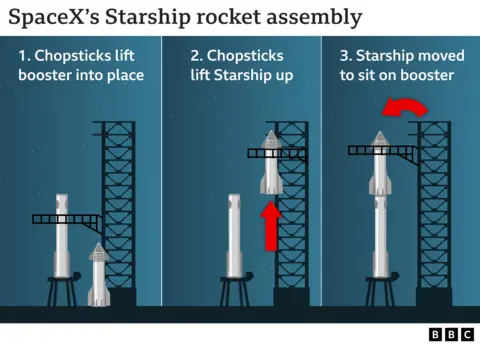
It’s also about twice as powerful as the Saturn V rocket which first took humanity to the Moon’s surface.
SpaceX says that power should be able to move a payload weighing at least 150 tonnes from the launchpad to low-Earth orbit.
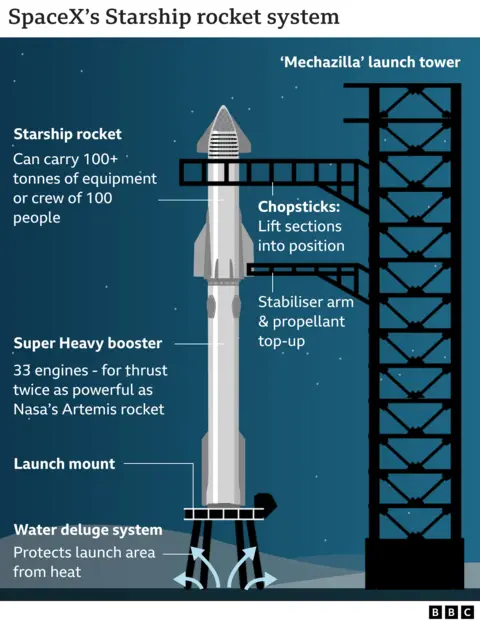
Both the Ship and the Super Heavy booster are fuelled with a mixture of icy-cold liquid methane and liquid oxygen fuel, known as methalox.
What has Starship done so far?
Starship has had four test flights up to now. During the first flight, the rocket system exploded early, before the Booster was able to separate.
It’s worth noting that such hiccups are part of SpaceX’s plan to speed up development by launching systems they know are not perfect and learning from the faults.
And each test has seen real progress – first with a hitch-free separation, and eventually a successful return, where both the Ship and the Booster made a controlled descent and hovered above the Indian Ocean and Gulf of Mexico respectively until splashing down.
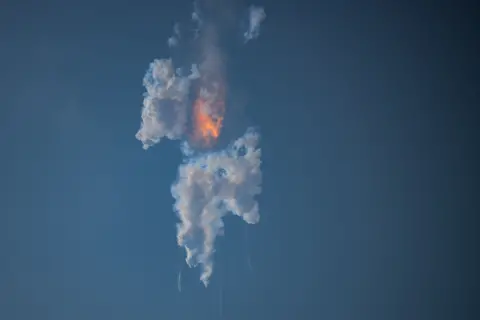 Getty Images
Getty ImagesHow does Starship land?
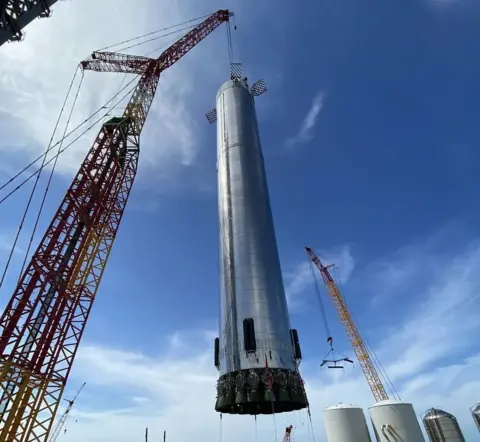 SpaceX
SpaceXAnyone watching nearby as the booster returns to Earth can expect a thunderous boom as it slows down from supersonic speeds.
While SpaceX plan to catch the booster with the launch tower, we won’t get a similar return of the top part – the Ship – this time. When we do, it shouldn’t look too different from the Super Heavy’s descent.
But since there’s no launch tower on Mars, or on the Moon for that matter, the Ship also needs to be able to land on its legs.
To do that, it manoeuvres itself horizontally as it starts to descend, in what Musk has called a ‘belly-flop’ manoeuvre. This increases the drag on the vehicle, slowing it down.
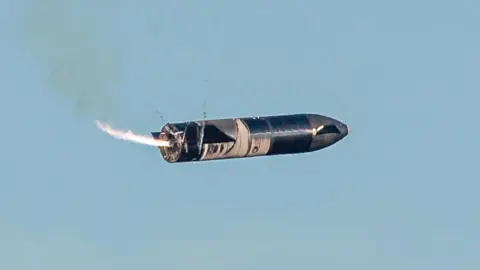 SpaceX
SpaceXOnce the Ship gets close enough to the surface, it’s then slow enough to fire its engines in a way that flips the vehicle into a vertical position.
The Ship then uses its rockets to guide itself down safely and land on a hard pad upon its landing legs.
All of this has been done by the Ship on its previous flight – apart from landing on a pad. So far it has only landed in the sea.

What are the challenges?
One of the purposes of test flying is to highlight problem areas, and the quick turnaround between each test flight means that weak links have to be redesigned at lightning speed.
If you get one thing wrong, the entire internal structure of the rocket could be melted by hot gases.
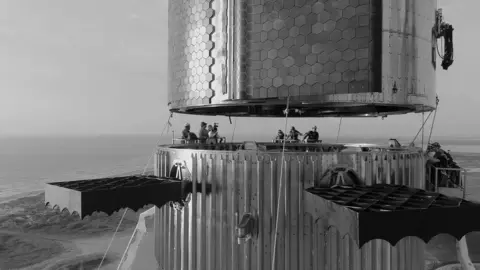 SpaceX
SpaceXWhat else will Starship be used for?
There are a few things Starship could be used for soon.
So far Musk has used his own rockets, like the Falcon 9 series, to launch his own commercial satellites, known as Starlink.
Those satellites have a short lifespan of around five years, and the flock in orbit needs to be constantly replenished just to keep the same number of satellites in space.
 Getty Images
Getty ImagesNasa also wants to use Starship as part of its Artemis programme, which aims to establish a long-term human presence on the Moon.
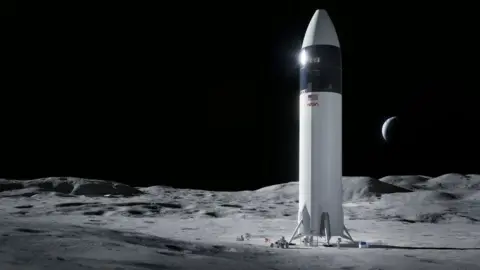 NASA
NASAIn the more distant future, Musk wants Starship to make long-haul trips to Mars and back – about a nine month trip each way.
“You could conceivably have five or six people per cabin, if you really wanted to crowd people in. But I think mostly we would expect to see two or three people per cabin, and so nominally about 100 people per flight to Mars,” Musk said.
The idea is to send the Ship part of the vehicle into low-Earth orbit, and “park” it there. It could then be refuelled in orbit by a SpaceX ‘tanker’ – essentially another Ship without the windows – for its onward journey to Mars.
It’s also conceivable that Starship could be used to launch space telescopes.
The Hubble telescope is about the size of a bus, and the James Webb telescope is almost three times as big as that.
To put up thousands of satellites quickly, or a bigger telescope, you need a big rocket.
Finally, Starship has also been built to carry heavy loads needed to build space stations, and eventually, infrastructure for a human presence on the Moon.
How much greenhouse gas does Starship emit?
A rocket that kicks 700 times harder than a passenger jet is bound to have some impact on the environment.
A draft environmental report by the US Federal Aviation Administration (FAA) released in July shows that the new licence SpaceX is applying for would allow them 25 launches of Starship per year.
The FAA say this would emit a total of 97,342 tonnes of CO2 equivalent – or 3,894 tonnes per launch.
In comparison, a typical car in the US emits about 4.6 tonnes of CO2 per year, according to the US Environmental Protection Agency.
If we crunch the numbers, that means one launch of Starship emits as much greenhouse gas as 846 cars would emit over the course of a year.
From a sheer numerical standpoint, that’s fairly insignificant compared to say, the commercial aviation industry.
But with Musk hoping to increase the number of launches to potentially hundreds per year in the future, those numbers could start adding up.
Technology
The FBI secretly created an Ethereum token to investigate crypto fraud

The FBI created a cryptocurrency as part of an investigation into price manipulation in crypto markets, the government revealed on Wednesday. The FBI’s Ethereum-based token, NexFundAI, was created with the help of “cooperating witnesses.”
As a result of the investigation, the Securities and Exchange Commission charged three “market makers” and nine people for allegedly engaging in schemes to boost the prices of certain crypto assets. The Department of Justice charged 18 people and entities for “widespread fraud and manipulation” in crypto markets.
The defendants allegedly made false claims about their tokens and executed so-called “wash trades” to create the impression of an active trading market, prosecutors claim. The three market makers — ZMQuant, CLS Global, and MyTrade — allegedly wash traded or conspired to wash trade on behalf of NexFundAI, an Ethereum-based token they didn’t realize was created by the FBI.
“What the FBI uncovered in this case is essentially a new twist to old-school financial crime,” Jodi Cohen, the special agent in charge of the FBI’s Boston division, said in a statement. “What we uncovered has resulted in charges against the leadership of four cryptocurrency companies, and four crypto ‘market makers’ and their employees who are accused of spearheading a sophisticated trading scheme that allegedly bilked honest investors out of millions of dollars.”
Liu Zhou, a “market maker” working with MyTrade MM, allegedly told promoters of NexFundAI that MyTrade MM was better than its competitors because they “control the pump and dump” allowing them to “do inside trading easily.”
An FBI spokesperson told CoinDesk that there was limited trading activity on the coin but didn’t share additional information. On a Wednesday press call, Joshua Levy, the acting US attorney for the District of Massachusetts, said trading on the token was disabled, according to CoinDesk.
The DOJ has reportedly secured $25 million from “fraudulent proceeds” that will be returned to investors.
Servers computers
TUTORIAL PERAKITAN CLOSE RACK 19 42U DAN 45U DEPTH 1150MM INDORACK
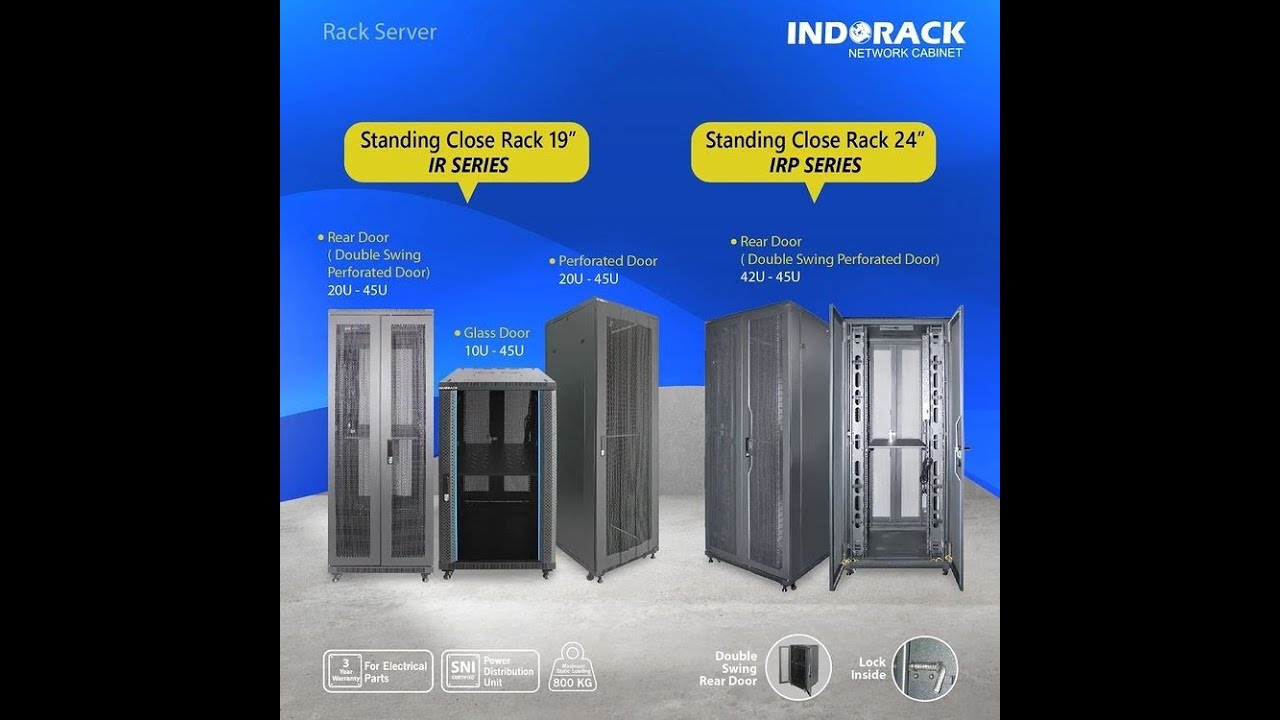
Tutorial Perakitan Standing Close Rack 19” INDORACK Type ini dapat diaplikasikan untuk tipe – tipe Rack Server di bawah ini:
IR11542G / 1150mm / 42U / Glass Door
IR11542P / 1150mm / 42U / Perforated Door
IR11545G / 1150mm / 42U / Glass Door
IR11545P / 1150mm / 42U / Perforated Door
VIDIO BY INDORACK
source
Technology
Is Verizon down again? Live updates on the service outage


It’s only been 10 days since Verizon’s major network outage took out service across the United States, but it seems that the big-red-themed carrier is having yet another service disruption, potentially another major outage.
We’ve been tracking reported outages via Down Detector, which have also been fluctuating over the past 24 hours. However, for about the last hour, dating back to 1PM ET, there has been a steady increase, hitting over 1,500 reported outages. This means that Verizon customers are noticing no connectivity bars, trouble making or receiving calls, and even spotting SOS at the top of their phones.
Ahead, we’ll be reporting live on this outage and its potential impact of us, so stick with TechRadar for the latest on what might be Verizon’s second major outage in less than two weeks. We’ve also reached out to Verizon to ask for a comment and to see if this is an official outage.
-

 Science & Environment3 weeks ago
Science & Environment3 weeks agoHyperelastic gel is one of the stretchiest materials known to science
-

 Science & Environment3 weeks ago
Science & Environment3 weeks agoHow to unsnarl a tangle of threads, according to physics
-

 Womens Workouts2 weeks ago
Womens Workouts2 weeks ago3 Day Full Body Women’s Dumbbell Only Workout
-

 Technology3 weeks ago
Technology3 weeks agoWould-be reality TV contestants ‘not looking real’
-

 Science & Environment3 weeks ago
Science & Environment3 weeks agoMaxwell’s demon charges quantum batteries inside of a quantum computer
-

 Science & Environment3 weeks ago
Science & Environment3 weeks ago‘Running of the bulls’ festival crowds move like charged particles
-
News3 weeks ago
the pick of new debut fiction
-

 Science & Environment3 weeks ago
Science & Environment3 weeks agoITER: Is the world’s biggest fusion experiment dead after new delay to 2035?
-

 Science & Environment3 weeks ago
Science & Environment3 weeks agoHow to wrap your mind around the real multiverse
-

 Science & Environment3 weeks ago
Science & Environment3 weeks agoSunlight-trapping device can generate temperatures over 1000°C
-

 Science & Environment3 weeks ago
Science & Environment3 weeks agoQuantum ‘supersolid’ matter stirred using magnets
-

 Science & Environment3 weeks ago
Science & Environment3 weeks agoLiquid crystals could improve quantum communication devices
-

 News3 weeks ago
News3 weeks agoOur millionaire neighbour blocks us from using public footpath & screams at us in street.. it’s like living in a WARZONE – WordupNews
-

 Science & Environment3 weeks ago
Science & Environment3 weeks agoQuantum forces used to automatically assemble tiny device
-

 Science & Environment3 weeks ago
Science & Environment3 weeks agoWhy this is a golden age for life to thrive across the universe
-

 Science & Environment3 weeks ago
Science & Environment3 weeks agoNerve fibres in the brain could generate quantum entanglement
-

 Science & Environment3 weeks ago
Science & Environment3 weeks agoPhysicists are grappling with their own reproducibility crisis
-

 Science & Environment3 weeks ago
Science & Environment3 weeks agoTime travel sci-fi novel is a rip-roaringly good thought experiment
-

 Science & Environment3 weeks ago
Science & Environment3 weeks agoLaser helps turn an electron into a coil of mass and charge
-

 Science & Environment3 weeks ago
Science & Environment3 weeks agoNuclear fusion experiment overcomes two key operating hurdles
-

 Science & Environment2 weeks ago
Science & Environment2 weeks agoX-rays reveal half-billion-year-old insect ancestor
-
Business2 weeks ago
Eurosceptic Andrej Babiš eyes return to power in Czech Republic
-

 News4 weeks ago
News4 weeks ago▶️ Hamas in the West Bank: Rising Support and Deadly Attacks You Might Not Know About
-

 Science & Environment3 weeks ago
Science & Environment3 weeks agoCaroline Ellison aims to duck prison sentence for role in FTX collapse
-

 News3 weeks ago
News3 weeks agoYou’re a Hypocrite, And So Am I
-

 Sport3 weeks ago
Sport3 weeks agoJoshua vs Dubois: Chris Eubank Jr says ‘AJ’ could beat Tyson Fury and any other heavyweight in the world
-

 Science & Environment3 weeks ago
Science & Environment3 weeks agoA slight curve helps rocks make the biggest splash
-

 News3 weeks ago
News3 weeks ago▶️ Media Bias: How They Spin Attack on Hezbollah and Ignore the Reality
-

 Technology2 weeks ago
Technology2 weeks ago‘From a toaster to a server’: UK startup promises 5x ‘speed up without changing a line of code’ as it plans to take on Nvidia, AMD in the generative AI battlefield
-

 Football2 weeks ago
Football2 weeks agoFootball Focus: Martin Keown on Liverpool’s Alisson Becker
-

 News3 weeks ago
News3 weeks agoNew investigation ordered into ‘doorstep murder’ of Alistair Wilson
-

 Science & Environment3 weeks ago
Science & Environment3 weeks agoRethinking space and time could let us do away with dark matter
-
Business2 weeks ago
Should London’s tax exiles head for Spain, Italy . . . or Wales?
-

 MMA2 weeks ago
MMA2 weeks agoConor McGregor challenges ‘woeful’ Belal Muhammad, tells Ilia Topuria it’s ‘on sight’
-

 Science & Environment3 weeks ago
Science & Environment3 weeks agoA new kind of experiment at the Large Hadron Collider could unravel quantum reality
-

 Science & Environment3 weeks ago
Science & Environment3 weeks agoFuture of fusion: How the UK’s JET reactor paved the way for ITER
-

 Technology2 weeks ago
Technology2 weeks agoIs sharing your smartphone PIN part of a healthy relationship?
-

 Science & Environment3 weeks ago
Science & Environment3 weeks agoWhy we need to invoke philosophy to judge bizarre concepts in science
-

 Science & Environment3 weeks ago
Science & Environment3 weeks agoA tale of two mysteries: ghostly neutrinos and the proton decay puzzle
-

 Science & Environment3 weeks ago
Science & Environment3 weeks agoUK spurns European invitation to join ITER nuclear fusion project
-

 News3 weeks ago
News3 weeks agoIsrael strikes Lebanese targets as Hizbollah chief warns of ‘red lines’ crossed
-

 Technology2 weeks ago
Technology2 weeks agoQuantum computers may work better when they ignore causality
-

 CryptoCurrency3 weeks ago
CryptoCurrency3 weeks agoCardano founder to meet Argentina president Javier Milei
-
News3 weeks ago
The Project Censored Newsletter – May 2024
-

 News3 weeks ago
News3 weeks agoWhy Is Everyone Excited About These Smart Insoles?
-

 Science & Environment3 weeks ago
Science & Environment3 weeks agoMeet the world's first female male model | 7.30
-

 News3 weeks ago
News3 weeks agoFour dead & 18 injured in horror mass shooting with victims ‘caught in crossfire’ as cops hunt multiple gunmen
-

 Womens Workouts2 weeks ago
Womens Workouts2 weeks ago3 Day Full Body Toning Workout for Women
-

 Technology2 weeks ago
Technology2 weeks agoRobo-tuna reveals how foldable fins help the speedy fish manoeuvre
-

 Technology2 weeks ago
Technology2 weeks agoGet ready for Meta Connect
-

 Health & fitness2 weeks ago
Health & fitness2 weeks agoThe 7 lifestyle habits you can stop now for a slimmer face by next week
-

 Sport2 weeks ago
Sport2 weeks agoWatch UFC star deliver ‘one of the most brutal knockouts ever’ that left opponent laid spark out on the canvas
-

 Technology3 weeks ago
Technology3 weeks agoThe ‘superfood’ taking over fields in northern India
-

 Health & fitness3 weeks ago
Health & fitness3 weeks agoThe maps that could hold the secret to curing cancer
-

 Health & fitness3 weeks ago
Health & fitness3 weeks agoThe secret to a six pack – and how to keep your washboard abs in 2022
-

 Science & Environment3 weeks ago
Science & Environment3 weeks agoBeing in two places at once could make a quantum battery charge faster
-

 CryptoCurrency3 weeks ago
CryptoCurrency3 weeks agoLow users, sex predators kill Korean metaverses, 3AC sues Terra: Asia Express
-
Politics3 weeks ago
UK consumer confidence falls sharply amid fears of ‘painful’ budget | Economics
-

 Womens Workouts3 weeks ago
Womens Workouts3 weeks agoBest Exercises if You Want to Build a Great Physique
-

 Womens Workouts3 weeks ago
Womens Workouts3 weeks agoEverything a Beginner Needs to Know About Squatting
-

 TV3 weeks ago
TV3 weeks agoCNN TÜRK – 🔴 Canlı Yayın ᴴᴰ – Canlı TV izle
-

 Science & Environment3 weeks ago
Science & Environment3 weeks agoCNN TÜRK – 🔴 Canlı Yayın ᴴᴰ – Canlı TV izle
-

 Servers computers2 weeks ago
Servers computers2 weeks agoWhat are the benefits of Blade servers compared to rack servers?
-

 Technology2 weeks ago
Technology2 weeks agoThe best robot vacuum cleaners of 2024
-
Business1 week ago
Ukraine faces its darkest hour
-
Business3 weeks ago
JPMorgan in talks to take over Apple credit card from Goldman Sachs
-

 Science & Environment3 weeks ago
Science & Environment3 weeks agoQuantum time travel: The experiment to ‘send a particle into the past’
-

 CryptoCurrency3 weeks ago
CryptoCurrency3 weeks agoBitcoin miners steamrolled after electricity thefts, exchange ‘closure’ scam: Asia Express
-

 CryptoCurrency3 weeks ago
CryptoCurrency3 weeks agoDorsey’s ‘marketplace of algorithms’ could fix social media… so why hasn’t it?
-

 CryptoCurrency3 weeks ago
CryptoCurrency3 weeks agoDZ Bank partners with Boerse Stuttgart for crypto trading
-

 CryptoCurrency3 weeks ago
CryptoCurrency3 weeks agoBitcoin bulls target $64K BTC price hurdle as US stocks eye new record
-

 Science & Environment3 weeks ago
Science & Environment3 weeks agoHow one theory ties together everything we know about the universe
-

 News3 weeks ago
News3 weeks agoChurch same-sex split affecting bishop appointments
-

 Science & Environment3 weeks ago
Science & Environment3 weeks agoTiny magnet could help measure gravity on the quantum scale
-

 CryptoCurrency3 weeks ago
CryptoCurrency3 weeks agoBlockdaemon mulls 2026 IPO: Report
-

 Sport3 weeks ago
Sport3 weeks agoUFC Edmonton fight card revealed, including Brandon Moreno vs. Amir Albazi headliner
-

 CryptoCurrency3 weeks ago
CryptoCurrency3 weeks agoEthereum is a 'contrarian bet' into 2025, says Bitwise exec
-

 News2 weeks ago
News2 weeks agoUS Newspapers Diluting Democratic Discourse with Political Bias
-

 Politics3 weeks ago
Politics3 weeks agoTrump says he will meet with Indian Prime Minister Narendra Modi next week
-

 CryptoCurrency3 weeks ago
CryptoCurrency3 weeks agoDecentraland X account hacked, phishing scam targets MANA airdrop
-

 Science & Environment3 weeks ago
Science & Environment3 weeks agoPhysicists have worked out how to melt any material
-

 CryptoCurrency3 weeks ago
CryptoCurrency3 weeks agoRedStone integrates first oracle price feeds on TON blockchain
-

 CryptoCurrency3 weeks ago
CryptoCurrency3 weeks ago‘No matter how bad it gets, there’s a lot going on with NFTs’: 24 Hours of Art, NFT Creator
-

 Science & Environment3 weeks ago
Science & Environment3 weeks agoHow do you recycle a nuclear fusion reactor? We’re about to find out
-
Business3 weeks ago
Thames Water seeks extension on debt terms to avoid renationalisation
-

 CryptoCurrency3 weeks ago
CryptoCurrency3 weeks agoCoinbase’s cbBTC surges to third-largest wrapped BTC token in just one week
-
Business3 weeks ago
How Labour donor’s largesse tarnished government’s squeaky clean image
-
Politics3 weeks ago
‘Appalling’ rows over Sue Gray must stop, senior ministers say | Sue Gray
-

 Technology3 weeks ago
Technology3 weeks agoiPhone 15 Pro Max Camera Review: Depth and Reach
-

 News3 weeks ago
News3 weeks agoBrian Tyree Henry on voicing young Megatron, his love for villain roles
-

 News3 weeks ago
News3 weeks agoBrian Tyree Henry on voicing young Megatron, his love for villain roles
-

 MMA3 weeks ago
MMA3 weeks agoRankings Show: Is Umar Nurmagomedov a lock to become UFC champion?
-

 Travel2 weeks ago
Travel2 weeks agoDelta signs codeshare agreement with SAS
-

 Politics2 weeks ago
Politics2 weeks agoHope, finally? Keir Starmer’s first conference in power – podcast | News
-

 News4 weeks ago
News4 weeks agoHow FedEx CEO Raj Subramaniam Is Adapting to a Post-Pandemic Economy
-

 CryptoCurrency3 weeks ago
CryptoCurrency3 weeks agoLouisiana takes first crypto payment over Bitcoin Lightning
-

 CryptoCurrency3 weeks ago
CryptoCurrency3 weeks agoCrypto scammers orchestrate massive hack on X but barely made $8K
-

 CryptoCurrency3 weeks ago
CryptoCurrency3 weeks agoTelegram bot Banana Gun’s users drained of over $1.9M
-

 Science & Environment3 weeks ago
Science & Environment3 weeks agoMost accurate clock ever can tick for 40 billion years without error
-

 CryptoCurrency3 weeks ago
CryptoCurrency3 weeks agoSEC asks court for four months to produce documents for Coinbase

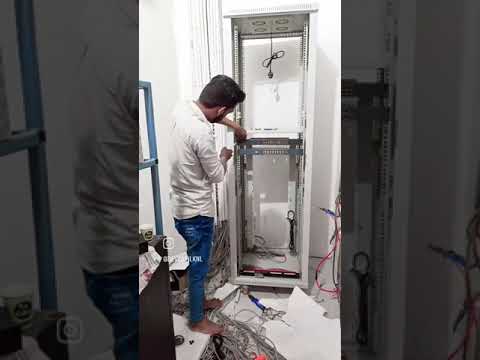

You must be logged in to post a comment Login